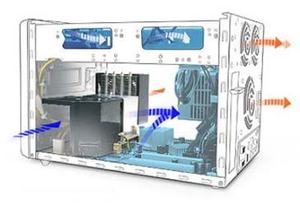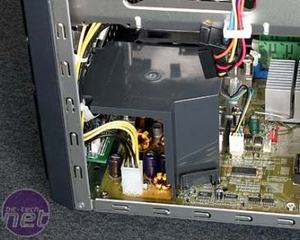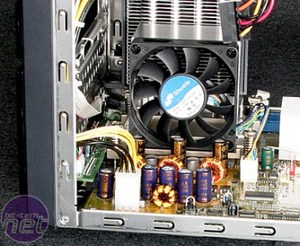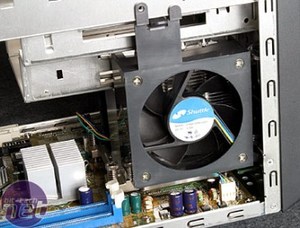
The main body is divided into three channels of air as you can see above.

The first passing over the Hard Drive located on the top of the machine through the two 60mm fans at the rear of the case.
The second flowing through the centre of the body of the unit, through the PSU fans, in this case cooling North Bridge and the Intel GMA 900 GPU.

The third in through that shroud...

...covering the various heat generating capacitors...

... past the ICE unit...

... and out through the side of the case (onto your hands if you have your shuttle next to your mousemat on the desk like I do).
The advantage of this last flow is a direct intake of cold air, concentrated on the heat sink and removed directly from the case; a bit like the BTX format is supposed to.
You are probably wondering, like I did, how loud this thing is going to be with a grand total of 5 fans whirring away stopping the SB81P from melting. The fans are self adjusting according to the temperature threshold you set within the BIOS or fixed according to a percentage also set by you. I went for the former as a little quieter system would be nicer to work with when staring at a screen between fragging sessions. I will give you a subjective opinion rather than decibel readings as they are considered inaccurate unless under strict testing conditions (the bit-tech Anechoic and Hemi-anechoic chambers are still just a pipe dream unfortunately).
The Ice cooling system works extremely well, with the noise emanating from the quintet of fans being acceptable at both idle and loaded states, even when overclocked. My only problem is the reaction time of the variable fan system, not unique to this Shuttle I might add. When the system rises in temperature the fans speed up gradually giving a smooth transition between noise levels, but when the system cools down a little the fans instantly readjust. This has an awful side effect of creating a whining noise, as the fans step up and down, akin to an engine revving. Adding a delay at the top end of the heat curve would eliminate this unfortunate problem, although it's a minor thing that I managed to get used to after a few hours of use.
There's me getting ahead of myself, let's see how I built it!

MSI MPG Velox 100R Chassis Review
October 14 2021 | 15:04







Want to comment? Please log in.